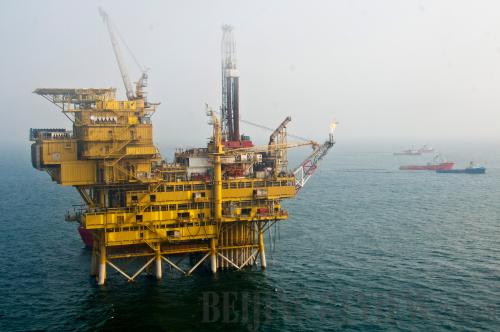|
 |
|
OFFSHORE OPERATION: Ships clean up spilled oil near Platform C of the Penglai 19-3 Oilfield on July 11 (GUO SHULEI) |
Scallop farmers in Laoting County in north China's Hebei Province had been unaware a catastrophe was approaching their farms south of the Bohai Bay until late June when they found millions of young scallops dead.
"Half the shellfish in the 7 million cages of scallops cultivated by 160 households in Laoting had already died and the majority of the remaining scallops were less than 1 centimeter in length," Xinhua News Agency reported later.
Yang Jizhen, head of the Laoting Aquaculture Association, estimated local scallop farmers suffered a total loss of 350 million yuan ($54 million).
Fishermen suspected the scallops' death was associated with oil contamination, saying it occurred after oil particles were observed in the area. "From mid to late June, slicks of oil were frequently seen on the seashore in Laoting," Yang said.
Li Jiafeng, a local fisherman, told Xinhua News Agency the quality of scallops is mainly determined by the quality of the sea water. He said there had been no red tides or abnormal occurrences other than the oil slicks that could account for the loss of the shellfish.
Soon, the fishermen's guess was confirmed.
On July 5, the State Oceanic Administration (SOA) said it had received reports on two oil leaks from the Penglai 19-3 Oilfield in the Bohai Bay, the largest off-shore oilfield in China. The first leak occurred on June 4, and another spill took place on June 17.
In partnership with the state-owned China National Offshore Oil Corp. (CNOOC), U.S. oil giant ConocoPhillips' Chinese subsidiary operates the oilfield.
Worse still, more leaks have been subsequently detected since the SOA made the accidents public.
The oil spill polluted about 4,240 square km of sea at its peak, according to the SOA.
Dried oil drops and oil belts have been detected in Liaoning, Hebei and Shandong provinces and Tianjin Municipality surrounding the Bohai Bay.
The SOA said on August 16 the countermeasures taken by ConocoPhillips China, such as deploying oil booms and easing pressure in the well, were provisional and would not effectively stem the risk of future spills.
Despite the Chinese Government's requirement for it to clean up the oil spill before August 31, ConocoPhillips China said on August 20 nine additional leaks near Platform C had appeared, with about two liters of "materials" seeping out every day.
Struggling farmers
Li Shuqiang, a local fisherman who has been cultivating scallops for over a decade, is typical of the hundreds of farmers in Laoting who now fear for their livelihoods.
Li said the business has usually brought excellent returns. Last year he earned more than 70,000 yuan ($10,955) from scallops. This year he expanded his production. But, as a result of the oil contamination, he said he was unlikely to recover his investment and return the more than 1 million yuan ($156,500) he borrowed from friends and relatives.
After the SOA announced the oil leaks from the Penglai 19-3 Oilfield, a joint investigation team was set up by the Laoting County Government to oversee aquatic production, oceanic administration and environmental protection. The team collected samples from the oil slicks in its offshore waters.
In early August, a document from Laoting County's Information Office said the oil particles collected by local investigators had been found to have originated from the Penglai 19-3 Oilfield.
But the North Sea Branch of the SOA said on August 2 the oil particles in the samples collected from Laoting's Laomigou area were fuel oil, rather than crude oil from the oil spill.
Laoting's fishermen found the SOA's test results unacceptable. The Laoting Aquaculture Association argued the mass death of scallops occurred around June 20, but the SOA's tests were based on oil samples collected on July 27 and 28.
| 